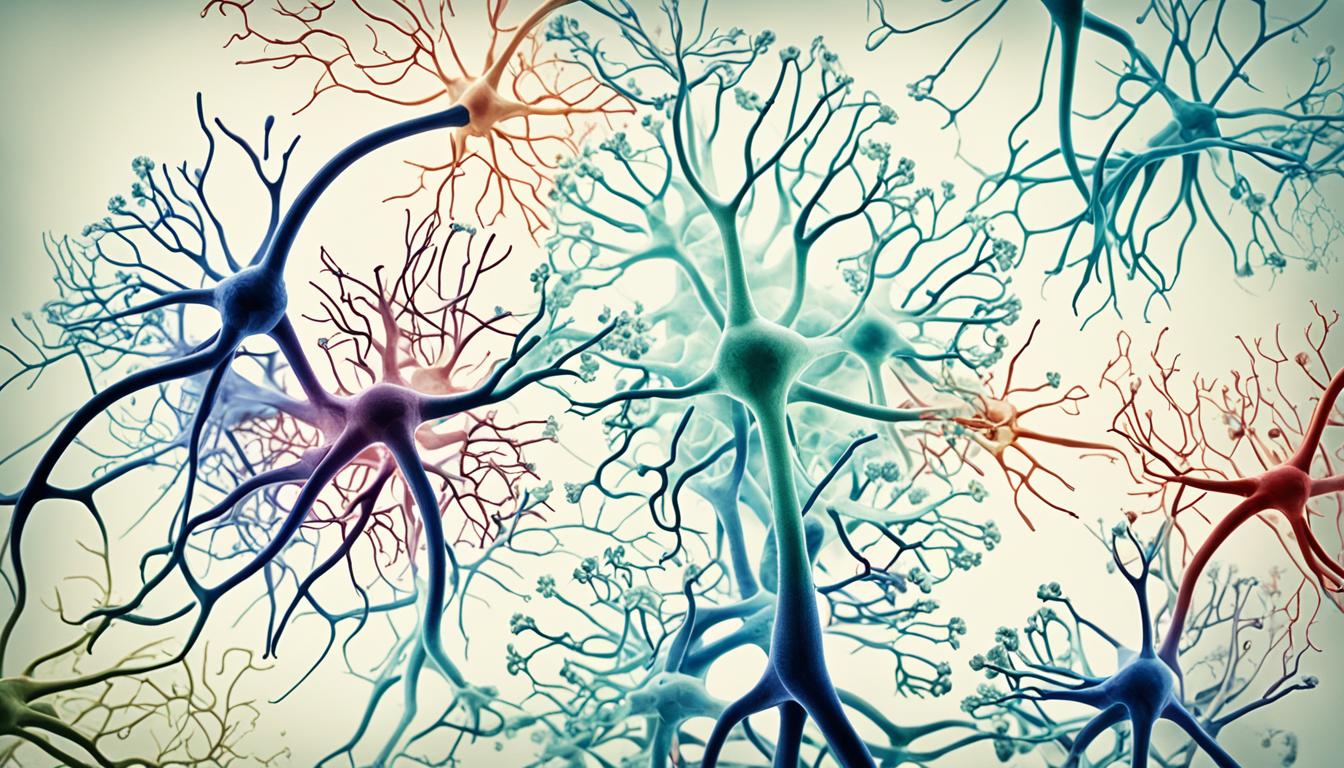Lou Gehrig’s disease, also known as Amyotrophic Lateral Sclerosis (ALS), is a serious condition. It affects nerve cells in the brain and spinal cord. The main cause of ALS is still a mystery, though some cases come from family genes.
This disease makes people lose control of their muscles. This loss of muscle control shows up as weakness, making it hard to walk or do daily tasks. ALS can also cause hands to feel weak or clumsy, mess up speech or swallowing, and lead to unexpected emotions like crying or laughing at the wrong times.
Nasty stuff, right? But it gets worse. As time goes on, ALS starts affecting bigger muscles like the ones used to move, talk, eat, and breathe. Sadly, right now there’s no cure for ALS. It’s a deadly disease.
Key Takeaways:
- Lou Gehrig’s disease, or ALS, is a serious nerve condition.
- The main cause of ALS is still a mystery, but sometimes it runs in families.
- It messes up muscle control, making it hard to move, eat, and breathe.
- Signs of ALS include muscle weakness, trouble walking, and slurred speech.
- There’s no cure, but treatments help with the symptoms and quality of life.
Symptoms of Lou Gehrig’s Disease
Lou Gehrig’s disease, or Amyotrophic Lateral Sclerosis (ALS), affects nerve cells in the brain and spinal cord. The symptoms vary but often start with muscle weakness. This can first show in the hands, legs, feet, or elsewhere. Muscle twitching is also common, which can be bothersome.
As ALS progresses, people might find walking or doing daily tasks challenging. They might trip or fall because of muscle weakness. This typically affects the legs but can happen in other areas too.
Hand weakness or being clumsy is another sign of this disease. It can make writing or holding things difficult. Speaking and swallowing might also get harder. This happens as the disease weakens these muscles over time.
Muscle cramps and twitching might show up in the arms and shoulders. Your tongue might also twitch. Some may find themselves crying, laughing, or yawning at the wrong times. This is because the nerves controlling these actions are not working properly.
If that’s not enough, ALS can also affect thinking or behavior. Some might have memory or concentration issues. These changes can make everyday life more challenging. Support may be needed to cope.
ALS often begins in the hands, feet, arms, or legs, then spreads. The disease’s progression weakens muscles over time. This can make eating, talking, or breathing hard.
But what’s interesting is, pain is not typically felt with ALS. Nor does it affect bladder control or the senses much. For these reasons, ALS can be hard to spot at first.
Causes and Risk Factors of Lou Gehrig’s Disease
Lou Gehrig’s disease, or Amyotrophic Lateral Sclerosis (ALS), has an unknown cause. It’s likely due to genes and environmental influences. Only about 10% of ALS cases are directly linked to genes.
Some risk factors for ALS include specific gene changes and getting older. The risk goes up, especially before reaching 75 years.
ALS appears more often in men than in women. The cause of this difference isn’t clear but could involve hormones or other biological factors.
Some environmental things might also increase the ALS risk. This includes smoking and being around certain metals or chemicals like lead.
Infections, injuries, and intense physical work during military service may also play a role. But, more studies are required to really understand their impact on ALS development.
Risk Factors for Lou Gehrig’s Disease
| Risk Factors | Description |
|---|---|
| Genetics | A small percentage of ALS cases have a genetic cause. |
| Age | The risk of developing ALS increases with age, particularly up to age 75. |
| Sex | ALS is slightly more common in men than in women. |
| Smoking | Exposure to tobacco smoke has been identified as an environmental risk factor for ALS. |
| Environmental Factors | Exposure to certain metals or chemicals, viral infections, and traumatic injuries may increase the risk of developing ALS. |
| Military Service | Intense exertion during military service has been associated with a higher risk of ALS. |
Stem Cell Therapy and Treatment for Lou Gehrig’s Disease
There’s no cure for Lou Gehrig’s disease. But, treatments can improve life quality for ALS patients. The goal is to slow down the disease and help people with daily tasks.
Healthcare teams offer support, designing plans for each person. They can give special devices for easier moving.
Two approved drugs, Riluzole and Edaravone, help by slowing down symptoms. They work by reducing a neurotransmitter that harms nerves. Stem cell therapy is also under study for Lou Gehrig’s disease.
Scientists are looking into how stem cell therapy can help ALS patients in research and trials. Stem cells might fix nerve cells, which could be a big step forward in ALS treatment. But, we still need to learn a lot more about its benefits and risks.

